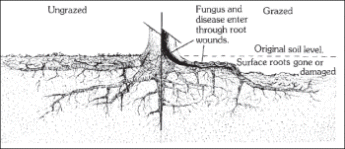Green Horizons
Volume 18, Number 1Winter 2014
Grazing your woods with silvopasture
By Brian Schweiss
Silvopasture is a touchy subject with some foresters. It is the intentional managed grazing of woods to utilize the forage in the understory, while maintaining a crop of trees for a variety of purposes. In the previous issue of Green Horizons, goat silvopasture was featured as a solution to reduce or eliminate the presence of exotic plants in the woods.
Many successful silvopasture stories begin with pine plantations. In these planted forests, trees that have grown beyond the reach of livestock are thinned and forage is established. Sometimes trees are planted at a wider spacing than normal to accommodate cattle. In oak hickory woods and forests, this can be trickier.
There are several legitimate concerns with silvopasture. The grazing of woods may lead to an eventual conversion without any management. Many woods have been grazed which can lead to altered species composition. Livestock are more likely to eat oak seedlings than hickory seedlings. Even years after livestock are removed, some woods are dominated by hickories. If grazing continues and the forest is thinned to promote forage, over time, the forest may be increasingly thinned until it becomes more like a park than a woodland.
Another concern some have with unmanaged grazing, which is not silvopasture, is that it could lead to increased erosion. Soil erosion inundisturbed woods is very minimal because trees, shrubs, herbaceous vegetation and leaf litter provide great erosion control. Many unmanaged, grazed woods are full of trees but do not have shrubs or ground cover. With enough grazing, even the leaf layer can disappear. Along with added soil compaction, there is increased erosion.
There is also the issue of reduced wildlife value. With the erosion, there is also a lack of cover and food for wildlife. Many wildlife species, from birds to deer, benefit from more diverse woods with groundcover, shrubs and trees. The livestock grazing reduces the diversity. Similarly, heavy deer browsing will damage trees and shrubs.
Sometimes grazing can lead to undesirable trees and plants. Livestock eat seeds, but they do not fully digest them. As the livestock move around in pastures and woods, they deposit these seeds. I will never forget seeing a honey locust seedling growing out of a cow patty!
Concern also stems from worries about damaging desirable trees. If the end goal for a forest is veneer walnuts or oaks, livestock introduction may not be the best path. Simply keeping livestock away from trees with metal structures does not always work because the area around it often becomes heavily trampled. The structure protects the main bole of the tree, but the roots are not protected. Compaction and soil disturbance can crush and expose shallow roots. Rot can move through damaged roots into the tree.
Woods are also not always safe for livestock. Acorns, for example, can cause toxicity issues with cattle. I once discussed this with an elderly landowner who mentioned that when he was a kid, his job on the farm was "hog poler." Not understanding this, he explained it to me: "you strap a pole to the hog and lift him up into the tree so he can eat the acorns before they fall." Many farmers are aware of these issues but take their chances. Other dangerous plants include the black cherry and the Ohio buckeye.
If the above situations are happening, it is not silvopasture. The premise of silvopasture is that the woods and grazing opportunities are actively managed and maintained to minimize tree damage. It requires all of the things that Dr. Charlotte Clifford-Rathert advocated in the last issue of Green Horizons. Anything other than that is forest grazing and all foresters and agroforesters agree that unmanaged forest grazing hurts your forest.
 |
 |
COURTESY OF MDC |
COURTESY OF MDC |